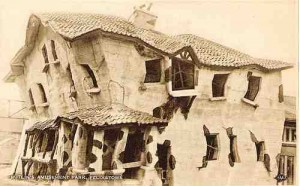History
A Little More Light Weirdness
Just some un-themed oddities that caught my eye:Plans to chop down a tree to make way for a roundabout in Jaslo, Poland have revealed that the oak was in fact planted to commemorate Hitler's birthday when the town was occupied during World War 2. The town's mayor, Maria Kurowska, called the choice between traffic improvements and the living memorial "simple," but not everyone agrees. "It's a historic curiosity," said local Kazimierz Polak, who was present at the planting ceremony as a child 67 years ago, adding, "It's not the tree's fault" (Reuters).
Two Bengal white tigers in a zoo in South Africa have given birth to a tiger cub that's not only white, but stripe-less (London Paper). Surely that's just called a lion?
A spiritual "healer" in Puerto Rico may want to re-read the manual today, after accidentally dropping a lit candle into the bath of alcohol he had instructed he lady patient lie in. The victim, who was suffering financial and marriage issues, can now add 50% burns to her list of problems (Metro).
The Swiss state of Appenzell went the whole of the second world war without a single German invader, so was perhaps unprepared to come under sustained assault by German hikers dressed in nothing but their socks and boots. Naked hiking, which has become a popular Alpine pastime apparently, has generated a stream of complaints from Swiss locals, and the authorities of the Outer and Inner Rhodes provinces of Appenzell have responded by imposing stiff fines of 200CHF ($175) on anyone caught without clothes, though where they expect the hikers to produce the money from is not explained (Cape News). To publicise the ban, the Swiss officials have ordered signs banning nude hiking, to the surprise of designer Dan Walter, who originally drew the sign as a joke (Metro).
Posted By: Dumbfounded - Tue Jul 07, 2009 -
Comments (6)
Category: Accidents, Goofs and Screw-ups, Animals, Government, Regulations, Health, History, Historical Figure, New Age
But Where Did They Get The Concrete?

Posted By: Dumbfounded - Tue Jul 07, 2009 -
Comments (4)
Category: Architecture, History, Goofs and Screw-ups
The Missing Link

Now I don't generally have a problem with thinking that my great, great, great (many greats) ancestors were apes. Especially judging by some of the men I've dated. But lemurs? Did any of you see the movie, Madagascar?
Posted By: Nethie - Tue Jun 02, 2009 -
Comments (13)
Category: Animals, History, Science, More Things To Worry About
Drunk Drivers Can Hit Anything, And Will

Posted By: Nethie - Mon May 18, 2009 -
Comments (3)
Category: History, Nature, 1970s, Africa, Alcohol
Breaking the Ice

Back in 1917, Railroad workers in Alaska who were bored during a long winter, set up a betting pool in which the winner determined the date and time that the ice on the Tanana River would break. Since then the event has grown to become the Nenana Ice Classic which attracts thousands. This year's jackpot is $283,723.00. But the neatest part is how they mark when the ice has broken. A wooden tripod is set up on the ice and wired to a clock in a tower along the shore. The winning time is determined when the ice moves enough to tighten the wire and trip the clock.
Posted By: Nethie - Mon May 11, 2009 -
Comments (2)
Category: Boredom, Contests, Races and Other Competitions, History, Nature
The Baron of Arizona
Bernie Madoff was a piker.He stole a few score billion dollars.
But how much is a whole state worth? All the land, natural resources, and structures?
That's what James Addison Reavis stole--almost getting away with the theft too.
Last night I watched THE BARON OF ARIZONA, a 1950 film by Samuel Fuller and starring Vincent Price. It tells the true story of Reavis, who cooked up an incredible con job to lay claim to the entire territory of Arizona in the year 1883.
You can read a fascinating essay about it here.
This is one film definitely worth renting for those with a taste for weird history.
Posted By: Paul - Wed Apr 29, 2009 -
Comments (1)
Category: Frauds, Cons and Scams, History, Historical Figure, Wild West and US Frontier, Hoaxes and Imposters and Imitators, Movies, Nineteenth Century, Arizona
1979 Disco Riot
With these hard times, who's to say that anti-disco riots will not spontaneously break out again?
Posted By: Paul - Thu Feb 05, 2009 -
Comments (10)
Category: Fads, History, Music, Riots, Protests and Civil Disobedience, 1970s
The Camisards

Well, not all the time.
Consider the French Protestant dissenters known as the Camisards.
I learned about this historical incident from reading Robert Louis Stevenson's Travels with a Donkey. (You can find the entire text of the book here.) Stevenson traveled through the region once ruled by the Camisards, and evoked the romance of their rebellion.
There, a hundred and eighty years ago, was the chivalrous Roland, "Count and Lord Roland, generalissimo of the Protestants in France," grave, silent, imperious, pock-marked ex-dragoon, whom a lady followed in his wanderings out of love. There was Cavalier, a baker's apprentice with a genius for war, elected brigadier of Camisards at seventeen, to die at fifty-five the English governor of Jersey. There again was Castanet, a partisan in a voluminous peruke and with a taste for divinity. Strange generals who moved apart to take counsel with the God of Hosts, and fled or offered battle, set sentinels or slept in an unguarded camp, as the Spirit whispered to their hearts! And to follow these and other leaders was the rank file of prophets and disciples, bold, patient, hardy to run upon the mountains, cheering their rough life with psalms, eager to fight, eager to pray, listening devoutly to the oracles of brainsick children, and mystically putting a grain of wheat among the pewter balls with which they charged their muskets.
Pretty weird, huh? And right in Europe, not all that long ago.
The last sentence from Stevenson is particularly intriguing, since it conjures up comparisons to the Mai-Mai rebels in the Congo today, who believe that certain magical charms protect them against bullets; that their own bullets are invulnerable to counter charms; and that ritual cannibalism of their enemies is still a grand idea.
Once Europe had its own Mai-Mai's. Perhaps someday Africa will be rid of theirs.
Posted By: Paul - Thu Jan 22, 2009 -
Comments (10)
Category: Cannibalism, Death, Frauds, Cons and Scams, History, Historical Figure, Magic and Illusions and Sleight of Hand, Paranormal, Religion, War, Weapons, Foreign Customs, Africa, Europe, Eighteenth Century
Psych-Out
Once you have experienced the 1968 film PSYCH-OUT, you will be unable to return to your square, plastic, uptight lifestyle. Just the sight of Jack Nicholson's fake ponytail alone will trip you out!
Posted By: Paul - Fri Jan 16, 2009 -
Comments (9)
Category: Bums, Hobos, Tramps, Beggars, Panhandlers and Other Streetpeople, Costumes and Masks, Drugs, Fads, Fashion, Hair Styling, History, Hollywood, Inebriation and Intoxicants, Movies, Music, Regionalism, Sexuality, Stereotypes and Cliches, Surrealism, Bohemians, Beatniks, Hippies and Slackers, 1960s, Posters, Dance, Body Painting, Facial Hair
Butlin’s Crazy House
Old amusement park attractions are inevitably weird.
Consider the Crazy House once to be found in Felixstowe, UK.
These old postcard images come from the Flickr set of a fellow who uses the handle Photoaf.
The house was part of a Butlin's Amusement Park. For the history of the founder, Billy Butlin, eventually knighted for his recreational achievements, visit here.
Wouldn't you have loved to experience this park during its heyday, some seventy years ago?
Posted By: Paul - Tue Nov 25, 2008 -
Comments (4)
Category: Architecture, Buildings and Other Structures, Entertainment, Fairs, Amusement Parks, and Resorts, History, Photography and Photographers, Surrealism, Foreign Customs, 1930s

| Who We Are |
|---|
| Alex Boese Alex is the creator and curator of the Museum of Hoaxes. He's also the author of various weird, non-fiction, science-themed books such as Elephants on Acid and Psychedelic Apes. Paul Di Filippo Paul has been paid to put weird ideas into fictional form for over thirty years, in his career as a noted science fiction writer. He has recently begun blogging on many curious topics with three fellow writers at The Inferior 4+1. Contact Us |







